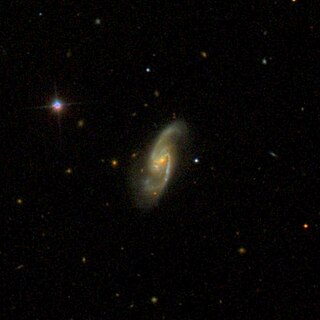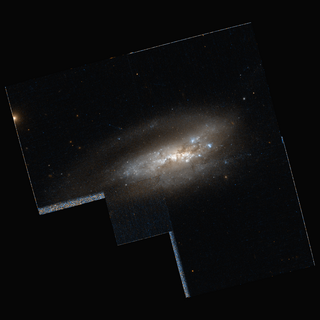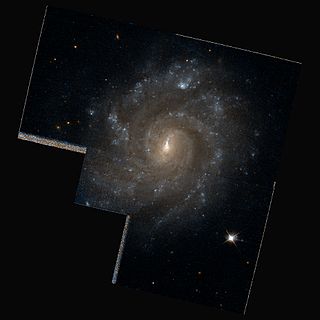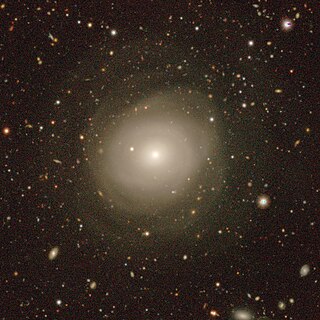
The Atlas of Peculiar Galaxies is a catalog of peculiar galaxies produced by Halton Arp in 1966. A total of 338 galaxies are presented in the atlas, which was originally published in 1966 by the California Institute of Technology. The primary goal of the catalog was to present photographs of examples of the different kinds of peculiar structures found among galaxies.

NGC 67 is an elliptical galaxy located in the constellation Andromeda that was discovered on October 7, 1855, by R. J. Mitchell, who described it as "extremely faint, very small, round". The galaxy belongs to the NGC 68 group, which also contains the galaxies NGC 68, NGC 69, NGC 70, NGC 71, NGC 72, and possibly NGC 74.

NGC 3041 is an intermediate barred spiral galaxy located in the constellation Leo. It is categorized as SAB(rs)c in the galaxy morphological classification scheme. It was discovered by William Herschel on 23 March 1784. The galaxy is approximately 77 million light years away from earth.

NGC 5256 is an object that contains two disc galaxies, that are colliding into each other. It is located in the constellation Ursa Major, and was discovered by William Herschel on 12 May 1787. The two nuclei of the galaxies are separated by about 13,000 light-years. The southwest and northeast nuclei have masses of 7×109 M☉ and 10×109 M☉, assuming they orbit around a common center of mass. NGC 5256 is located at about 420 million light-years away from the Earth.

NGC 5001 is a barred spiral galaxy located in the constellation Ursa Major. It is designated as SB in the galaxy morphological classification scheme. It was discovered by John Herschel on 1 May 1831. It is at a distance of 130 million parsecs from the Earth.

NGC 6000 is a barred spiral galaxy located in the constellation Scorpius. It is designated as SB(s)bc in the galaxy morphological classification scheme and was discovered by John Herschel on 8 May 1834. The galaxy is approximately 103 million light-years away. It is the brightest of all the galaxies in the constellation Scorpius.
Two supernovae have been observed in this galaxy, namely 2007ch and 2010as, each having a magnitude of about 17.2 and 15.5 respectively.

NGC 6104 is a barred spiral galaxy located in the constellation Corona Borealis. It is designated as S(R)Pec in the galaxy morphological classification scheme, though it is clearly a barred spiral, and was discovered by William Herschel on 16 May 1787. The galaxy is approximately 388 million light-years away.

NGC 6181 is a barred spiral galaxy located in the constellation Hercules. It is designated as SB(rs)c in the galaxy morphological classification scheme and was discovered by William Herschel on 28 April 1788. The galaxy is 107 million light years away.

NGC 6207 is a spiral galaxy located in the constellation Hercules. It is designated as SA(s)c in the galaxy morphological classification scheme and was discovered by William Herschel on 16 May 1787. NGC 6207 is located at about 30 million light-years from Earth. In the sky, it is located near the globular cluster Messier 13.

NGC 6212 is a spiral galaxy located in the constellation Hercules. It is designated as Sb in the galaxy morphological classification scheme and was discovered by the French astronomer Édouard Stephan on 26 July 1870. NGC 6212 is located at about 397 million light years from Earth.

NGC 6221 is a barred spiral galaxy located in the constellation Ara. In de Vaucouleurs' galaxy morphological classification scheme, it is classified as SB(s)bc and was discovered by British astronomer John Herschel on 3 May 1835. NGC 6221 is located at about 69 million light years from Earth.

NGC 6229 is a globular cluster located in the constellation Hercules. It is designated as GC(v)B in the galaxy morphological classification scheme and was discovered by the British astronomer William Herschel on 12 May 1787. NGC 6229 is located at about 100,000 light years away from Earth.

NGC 6239 is a barred spiral galaxy located in the constellation Hercules with a distinct core. It is designated as SB(s)B in the galaxy morphological classification scheme and was discovered by the German-born British astronomer William Herschel on 12 April 1788. The galaxy is approximately 42 million light years away from Earth.

NGC 6285 is an interacting spiral galaxy located in the constellation Draco. It is classified as S0-a in the galaxy morphological classification scheme and was discovered by the American astronomer Lewis A. Swift in 1886. NGC 6285 is located at about 262 million light years away from Earth. NGC 6285 and NGC 6286 form a pair of interacting galaxies, with tidal distortions, categorized as Arp 293 in the Arp Atlas of Peculiar Galaxies

NGC 6286 is an interacting spiral galaxy located in the constellation Draco. It is designated as Sb/P in the galaxy morphological classification scheme and was discovered by the American astronomer Lewis A. Swift on 13 August 1885. NGC 6286 is located at about 252 million light years away from Earth. NGC 6286 and NGC 6285 form a pair of interacting galaxies, with tidal distortions, categorized as Arp 293 in the Arp Atlas of Peculiar Galaxies.

NGC 6287 is a globular cluster located in the constellation Ophiuchus. It is designated as VII in the galaxy morphological classification scheme and was discovered by the German-born British astronomer William Herschel on 21 May 1784. It is at a distance of 30,300 light years away from Earth.

NGC 6300 is a barred Seyfert spiral galaxy located in the constellation Ara. It is classified as SB(rs)b in the galaxy morphological classification scheme and was discovered by the Scottish astronomer James Dunlop on 30 June 1826. NGC 6300 is located at about 51 million light years away from Earth. It is suspected that a massive black hole may be at its center, pulling all the nearby objects into it. In turn, it emits large amounts of X-rays.

NGC 6394 is a barred spiral galaxy located in the constellation Draco. It is designated as SBb in the galaxy morphological classification scheme and was discovered by the American astronomer Lewis A. Swift on 7 July 1885.

NGC 6412 is a spiral galaxy located in the constellation Draco. It is designated as SBc in the galaxy morphological classification scheme and was discovered by the British astronomer William Herschel on 12 December 1797. NGC 6412 is located at about 76.6Mly away from Earth.

NGC 466 is a lenticular galaxy located about 227 million light-years away from Earth in the constellation Tucana. NGC 466 was discovered by astronomer John Herschel on October 3, 1836.



















